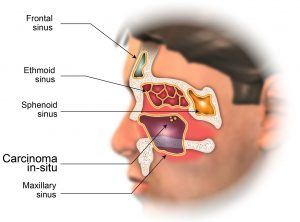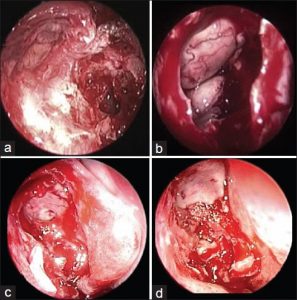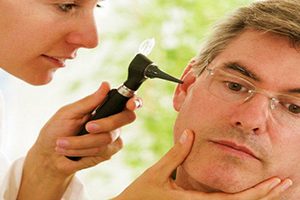Nose Treatment
Nose diseases can be caused by multiple conditions. Consult an Nose specialist in Nashik to avoid complications or problems related to your Nose.
Following are the treatments and services offered at ENT Care Centre for Nose diseases:
Nasal and Sinus Allergy Care

Allergy symptoms are bad enough on their own. But in many people, allergic rhinitis can cause or worsen other complexities or conditions.
What’s the connection between allergies and sinus problems?
Sinuses are deep pockets in the skull that are connected to the nasal passages. When allergies trigger swelling in the mucous membranes, the inflamed tissue can block off the sinuses. The sinuses can’t drain, trapping mucus and air inside. That leads to pain and pressure.
Nose Reshapning Procedure

Rhinoplasty, or nose reshaping is one of the most common of all plastic surgery procedures.
A lot of people are unhappy with the size and/or shape of their nose. The nose is central to facial balance and many people opt for surgical nose reshaping, or rhinoplasty, in an effort to find a more harmonious alignment of their features. Sometimes the problem can be more to do with the position of the chin or jaw, but patients tend to focus their dissatisfaction on the nose.
While surgical techniques are advanced, there are limitations as to how much the nose can be altered.
Outcomes depend on the size of the nose, the condition of the skin and the age of the patient. The most important thing is that there is clear communication between a patient and a surgeon about what is wanted and what is achievable.
Patients should also bear in mind that surgery alone will not solve any emotional or social problems they may attribute to their nose or to their appearance generally
Treatment of Sinosal Malignicies

What are sinonasal tumors?
Sinonasal tumors are tumors that occur in the nasal cavity or nasal sinuses. These tumors are rare, making up only about three percent of tumors in the upper respiratory tract. They are twice as common in males than in females.
What are some possible causes of sinonasal tumors?
There are actually many different types of tumors that can form in the nose or sinuses. Some of these are listed below:
- Inverted papillomas.
- Squamous cell carcinoma.
- Transitional cell carcinoma.
- Adenocarcinoma.
- Adenoid cystic carcinoma.
- Melanoma.
- Neuroblastoma.
- Sarcomas.
- Lymphoma.
- Plasmacytoma.
- Giant cell tumor.
- Metastatic carcinoma.
Inverted papillomas are benign tumors by definition, but can cause problems when they expand and destroy the bone. Five to twenty percent of these benign tumors may also transform into a malignant type if not treated.
Otherwise, squamous cell carcinomas are the most common malignant type of tumor, followed by adenoid cystic carcinoma and adenocarcinoma. Most of the tumors originate from the maxillary sinuses. Less commonly, it stems from the nasal cavity, ethmoid sinuses or even more rarely, from the frontal or sphenoid sinuses.
What are the symptoms of sinonasal tumors and how are they diagnosed?
Patients with sinonasal tumors often present with vague symptoms, including nasal obstruction, nasal congestion, and discharge, frequent bloody noses, headache, and/or facial pain. Patients can also have facial swelling, vision changes, or neurologic deficits. Some patients are asymptomatic.
Diagnosis begins with a thorough history and physical examination. Imaging studies such as CT scan and MRI are usually done to stage the tumor locally and to check for the presence of metastases, or spread. CT scans are better for the examination of the bony structures of the sinuses and skull base.
MRI is preferred for defining soft tissue details, such as an invasion of the dura (lining of the brain), orbit, or the brain itself. Biopsy of the tumor is necessary to make a final diagnosis. This can often be done in the office with a topical or local anesthetic. Sometimes the biopsy needs to be done in a more controlled setting like an operating room, especially if there is a risk of bleeding.
How are sinonasal tumors treated?
Surgical therapy is the main treatment for most sinonasal tumors. Radiation may be used as well. Radiation may be used alone if the tumor cannot be removed surgically or in patients who cannot tolerate surgery. Combination therapy of surgery and radiotherapy with or without chemotherapy is given in specific situations.
Type of surgery will depend on the size and spread of the tumor and surgeon preference. Approaches can be external or endoscopic. Removal of sinonasal tumors can leave patients with facial disfigurement and speech and swallowing difficulties. Reconstructive surgery is often done to help with these problems, usually using tissue from elsewhere in the body.
Csf Rhinorrhoea Repair Surgery

Cerebrospinal fluid (CSF) rhinorrhea has been a major treatment challenge for otolaryngologists and skull-base surgeons.
- Skull-base fractures and iatrogenic injuries are the main causes of CSF rhinorrhea.
- Repair is a must to avoid meningitis and pneumocephalus.
- Endoscopic repair is well recognized, since the first use of the endoscope in 1981.
- Septal mucoperiosteum, a free graft from temporalis fascia, fascia lata, free muscle, tragal perichondrium, abdominal fat or even an omental free flap or synthetic dural substitute have been used for repair.
- Fibrin glue has been used to secure the graft into position in earlier studies.
- The histopathological studies suggest that fibrin glue may trigger an inflammatory response that may promote healing.
- However, the efficacy of fibrin glue in preventing CSF leaks remains controversial.
- Encouraging results of endoscopic CSF repair without fibrin glue from our department encouraged us to compare the efficacy of repair with and without fibrin glue in pediatric patients.
Treatment of angiofibroma

The most common treatment for angiofibroma is surgery.
Angiofibromas may be approached directly using the Endoscopic Endonasal Approach (EEA). This state-of-the-art, minimally invasive approach allows surgeons to access the tumor through the natural corridor of the nose, without making an open incision. Surgeons then remove the angiofibroma through the nose and nasal cavities.
EEA offers the benefits of no incisions to heal, no disfigurement, and faster recovery time.
If you need complementary treatments, such as radiation, those therapies can begin soon after EEA surgery.
Prior to surgery, an angiogram may be performed. This imaging test uses x-rays to view blood vessels that have been injected with a contrasting dye, to allow for embolization of the tumor.
Embolization involves cutting off the blood supply to the tumor. It significantly reduces blood loss during surgery and tumor removal.
Radiation therapy
Radiation therapy may be used for people with angiofibroma tumors that have extended into the cranial cavity, can’t be reached safely by surgery, or have returned after previous treatment.
Chemotherapy
Hormonal flutamide, which blocks testosterone receptors, has been shown to reduce tumor size effectively. The use of this medication is restricted to those enrolled in clinical trials.
Nasal and Sinus Allergy care

Sinus infection symptoms
A bad cold is often mistaken for a sinus infection. Many symptoms are the same, including headache or facial pain, runny nose and nasal congestion. Unlike a cold, sinus infection symptoms may be caused by bacterial infections. It often requires treatment with antibiotics (drugs that kill the germs causing the infection).
Sinus infection diagnosis
If you think you have a sinus infection, see your allergist for proper diagnosis. In most cases, sinus infection treatment is easy. By stopping a sinus infection early, you avoid later symptoms and complications.
What is sinusitis?
Sinusitis is an inflammation of the sinuses. It is often caused by bacterial (germ) infection. Sometimes, viruses and fungi (molds) cause it. People with weak immune systems are more likely to develop a bacterial or fungal sinus infection. Some people with allergies can have “allergic fungal sinus infection.” Acute sinus infection lasts three to eight weeks. A sinus infection lasting longer than eight weeks is considered chronic.
The sinuses are air-filled cavities. They are located:
- Within the bony structure of the cheeks
- Behind the forehead and eyebrows
- On either side of the bridge of the nose
- Behind the nose directly in front of the brain
An infection of the sinus cavity close to the brain can be life-threatening, if not treated. In rare cases, it can spread to the brain. Normal sinuses are lined with a thin layer of mucus that traps dust, germs and other particles in the air.
Tiny hair-like projections in the sinuses sweep the mucus (and whatever is trapped in it) towards openings that lead to the back of the throat. From there, it slides down to the stomach. This continual process is a normal body function.
A sinus infection stops the normal flow of mucus from the sinuses to the back of the throat. The tiny hair-like “sweepers” become blocked when infections or allergies cause tiny nasal tissues to swell. The swelling traps mucus in the sinuses.
Some people have bodily defects that contribute to sinus infection. The most common of these defects are:
- Deformity of the bony partition between the two nasal passages
- Nasal polyps (benign nasal growths that contain mucus)
- A narrowing of the sinus openings People with these defects often suffers from chronic sinus infections.
Related resources:
- Rhinitis
- Allergy symptoms
- Find an allergist
- Symptoms
Common symptoms of sinus infection include:
- Postnasal drip
- Discolored nasal discharge (greenish in color)
- Nasal stuffiness or congestion
- Tenderness of the face (particularly under the eyes or at the bridge of the nose)
- Frontal headaches
- Pain in the teeth
- Coughing
- Fever
- Fatigue
- Bad breath
Sinus infection (sinusitis) is often confused with rhinitis, a medical term used to describe the symptoms that accompany nasal inflammation and irritation. Rhinitis only involves the nasal passages. It could be caused by a cold or allergies.
Allergies can play an important role in chronic (long-lasting) or seasonal rhinitis episodes. Nasal and sinus passages become swollen, congested, and inflamed in an attempt to flush out offending inhaled particles that trigger allergies. Pollen is seasonal allergens. Molds, dust mites, and pet dander can cause symptoms year-round.
Asthma also has been linked to chronic sinus infections. Some people with chronic nasal inflammation and irritation and/or asthma can develop a type of chronic sinusitis that is not caused by infection. Appropriate treatment of sinus infection often improves asthma symptoms.
How is sinus infection diagnosed?
Diagnosis depends on symptoms and requires an examination of the throat, nose, and sinuses. Your allergist will look for:
- Redness
- Swelling of the nasal tissues
- Tenderness of the face
- Discolored (greenish) nasal discharge
- Bad Breath
If your sinus infection lasts longer than eight weeks, or if standard antibiotic treatment is not working, a sinus CT scan may help your allergist diagnose the problem. Your allergist may examine your nose or sinus openings.
The exam uses a long, thin, flexible tube with a tiny camera and a light at one end that is inserted through the nose. It is not painful. Your allergist may give you a light anesthetic nasal spray to make you more comfortable.
Mucus cultures: If your sinus infection is chronic or has not improved after several rounds of antibiotics, a mucus culture may help to determine what is causing the infection. Most mucus samples are taken from the nose. However, it is sometimes necessary to get mucus (or pus) directly from the sinuses.
Knowing what kind of bacteria is causing the infection can lead to more effective antibiotic therapy. A fungus could also cause your sinus infection. Confirming the presence of fungus is important. Fungal sinus infection needs to be treated with antifungal agents, rather than antibiotics. In addition, some forms of fungal sinus infection – allergic fungal sinus infection, for example – do not respond to antifungal agents and often require the use of oral steroids.
Your allergist may consider ordering a sinus CT. This test can help to define the extent of the infection. Your allergist may also send you to a specialist in allergy and immunology. The specialist will check for underlying factors such as allergies, asthma, structural defects, or a weakness of the immune system.
Biopsies: A danger of more serious types of fungal sinus infection is that the fungus could penetrate into the nearby bone. Only a bone biopsy can determine if this has happened. Biopsies involving sinus tissue are taken with flexible instruments inserted through the nose.
Biopsies of the sinus tissue are also used to test for immotile cilia syndrome, a rare disorder that can cause people to suffer from recurrent infections, including chronic sinus infection, bronchitis, and pneumonia.
Treatment
- Antibiotics
Antibiotics are standard treatments for bacterial sinus infections. Antibiotics are usually taken from 3 to 28 days, depending on the type of antibiotic. Because the sinuses are deep-seated in the bones, and blood supply is limited, longer treatments may be prescribed for people with longer lasting or severe cases.
Overuse and abuse of antibiotics have been causing a major increase in antibiotic resistance. Therefore, patients with sinus symptoms should consider taking an antibiotic only if symptoms (including discolored nasal discharge) persist beyond 7-10 days.
Antibiotics help eliminate a sinus infection by attacking the bacteria that cause it, but until the drugs take effect, they do not do much to alleviate symptoms. Some over-the-counter medications can help provide relief. - Nasal decongestant sprays
Topical nasal decongestants can be helpful if used for no more than three to four days. These medications shrink swollen nasal passages, facilitating the flow of drainage from the sinuses. Overuse of topical nasal decongestants can result in a dependent condition in which the nasal passages swell shut, called rebound phenomenon. - Antihistamines
Antihistamines block inflammation caused by an allergic reaction so they can help to fight symptoms of allergies that can lead to swollen nasal and sinus passages.
Nasal decongestants and antihistamines
Over-the-counter combination drugs should be used with caution. Some of these drugs contain drying agents that can thicken mucus. Only use them when prescribed by your allergist. - Topical nasal corticosteroids
These prescription nasal sprays prevent and reverse inflammation and swelling in the nasal passages and sinus openings, addressing the biggest problem associated with a sinus infection. Topical nasal corticosteroid sprays are also effective in shrinking and preventing the return of nasal polyps. These sprays at the normal dose are not absorbed into the bloodstream and could be used over long periods of time without developing “addiction.” - Nasal saline washes
Nasal rinses can help clear thickened secretions from the nasal passages.
Surgery If drug therapies have failed, surgery may be recommended as a last resort. It is usually performed by an otolaryngologist. Anatomical defects are the most common target of surgery.
Your surgeon can fix defects in the bone separating the nasal passages, remove nasal polyps, and open up closed passages. Sinus surgery is performed under either local or general anesthesia, and patients often can go home on the same day.
Treatment of Sinonasal Malignancies

The structures inside the ear are very small, so the development of microsurgery has made it easier to perform more extensive surgery within this confined space.
Microsurgery is used for ear drum repair, to locate and remove small ear tumours, and to repair the bones within the ear if they have become damaged, or have degenerated. Surgery is performed through the ear drum, and then involves an ear drum reconstruction.
Insomnia Treatment

Insomnia is a common sleep disorder, that can make it hard to fall asleep. hard to stay asleep or cause you to wake up too early and not be able to get back to sleep. You may still feel tired when you wake up. Insomnia can sap not only your energy level and mood but also your health, work performance and quality of life.
How much sleep is enough varies from person to person, but most adults need seven to eight hours a night. At some point, many adults experience short-term (acute) insomnia, which lasts for days or weeks. It’s usually the result of stress or a traumatic event.
But some people have long-term (chronic) insomnia that lasts for a month or more. Insomnia may be the primary problem, or it may be associated with other medical conditions or medications.
You don’t have to put up with sleepless nights. Simple changes in your daily habits can often help.
Symptoms
- Insomnia symptoms may include:
- Difficulty falling asleep at night
- Waking up during the night
- Waking up too early
- Not feeling well-rested after a night’s sleep
- Daytime tiredness or sleepiness
- Irritability, depression or anxiety
- Difficulty paying attention, focusing on tasks or remembering
- Increased errors or accidents
- Ongoing worries about sleep
